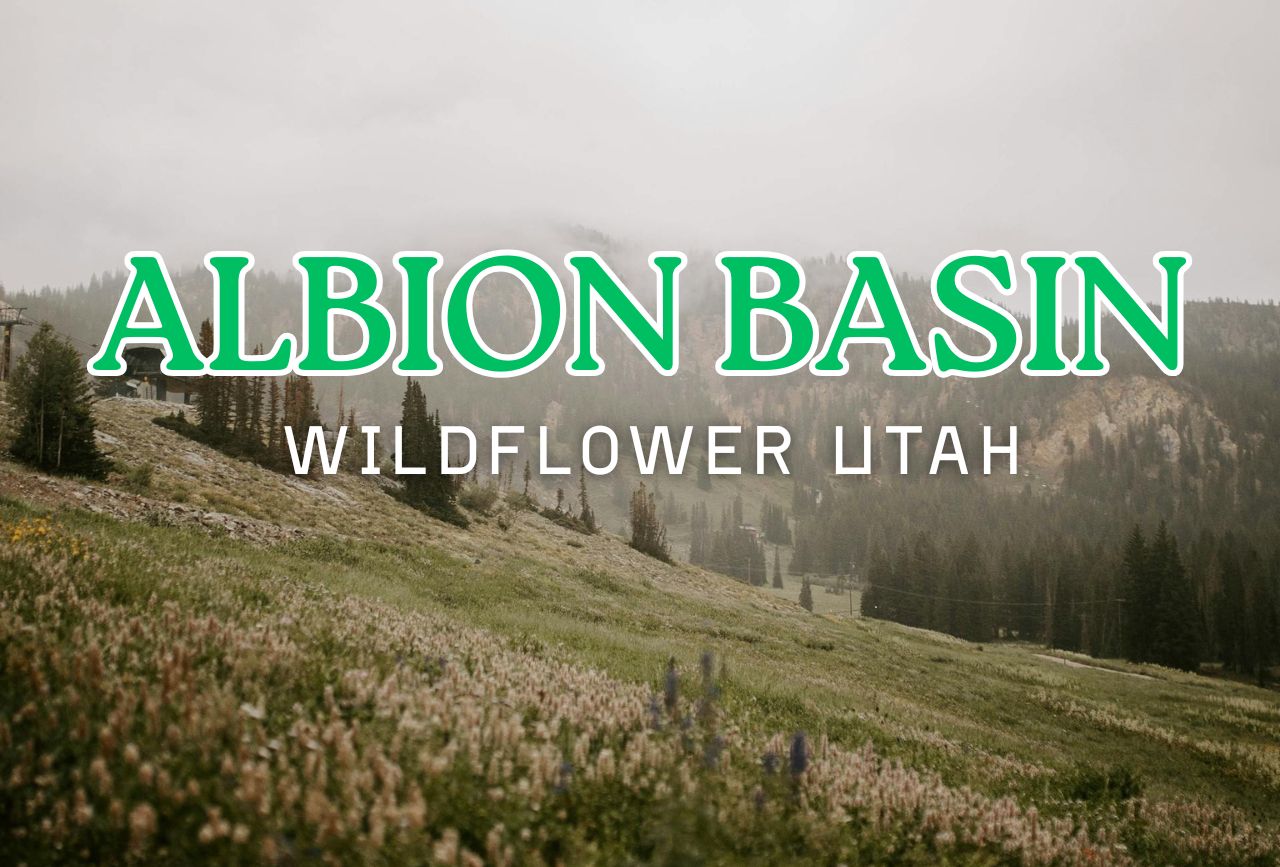Nestled in the Wasatch Range, Albion Basin transforms every summer into a spectacular painter’s palette of wildflowers.
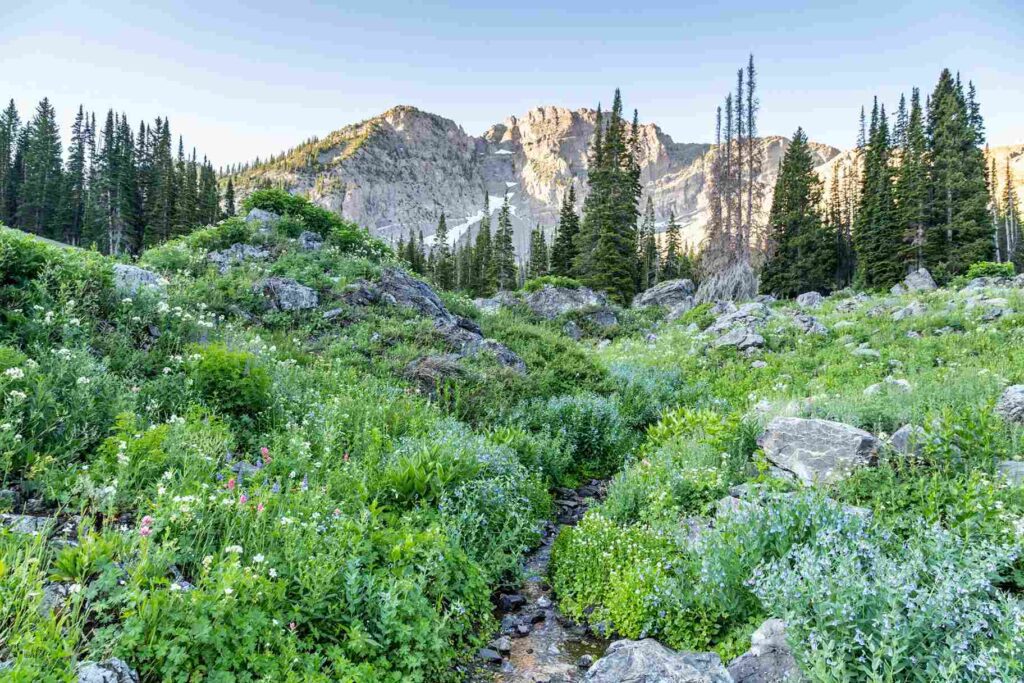
My hike along the 4.7km trail, starting at the Albion Base Parking Lot in Little Cottonwood Canyon, a 30-minute drive from downtown Salt Lake’s bustling rooftop bars and patios, revealed vibrant meadows that demand Instagram followers’ double-takes.
The Uinta-Wasatch-Cache National Forest’s scenic route, an out-and-back path with 216m elevation gain, takes 1h 35m to complete, winding through rocky, gravel sections of ski trails.
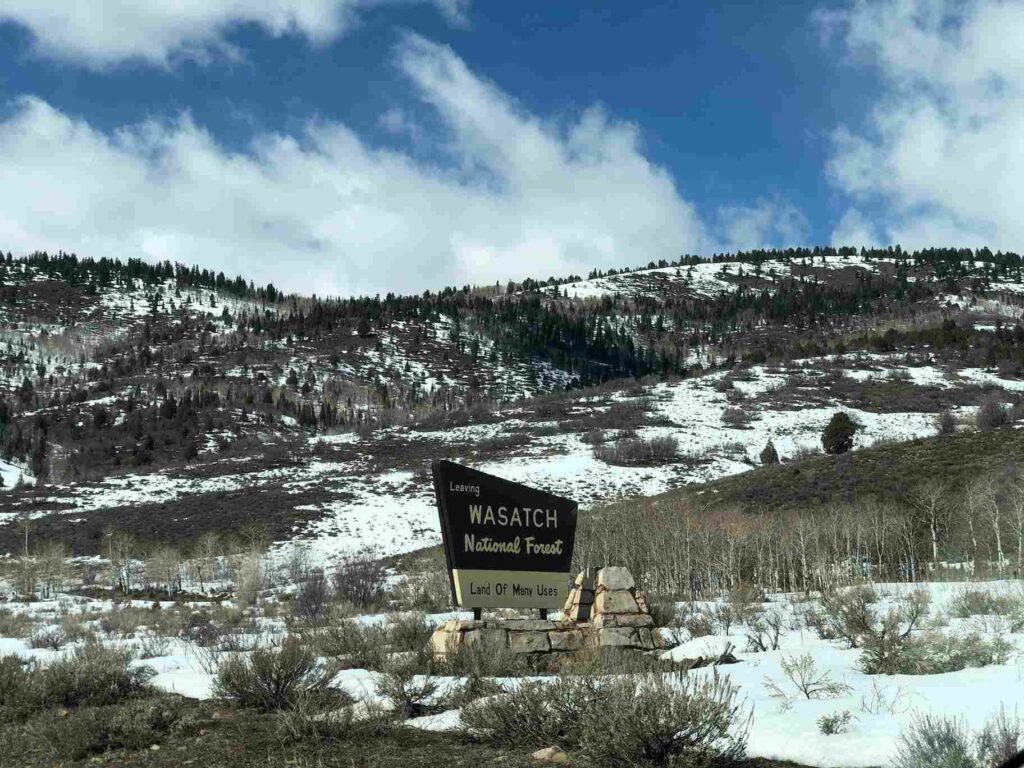
Pic of bluebells, red Indian Paintbrush, silvery lupine, purple columbines, rose-pink geraniums, bright yellow sunflowers, violet Penstemon, and white sego lily:
By end of July to early August, the Basin bursts with 120 species—bluebells, red Indian Paintbrush, silvery lupine, purple columbines, rose-pink geraniums, bright yellow sunflowers, violet Penstemon, and white sego lily, Utah’s State Flower—splashed across technicolor fields.
At 9500 feet in the Wasatch-Cache National Forest Ranger District, this world-famous destination in Alta Ski Area and Snowbird Resort draws thousands during the wildflower season.
The high-elevation alpine landscape, framed by jagged peaks, fragrant pine forests, and clear blue skies, creates a breathtaking gallery. The magnificent explosions of colorful flowers against mountain backdrops make this a must-see for nature lovers.
The trail begins gently but includes rocky parts, so sturdy shoes and insect repellant are recommended. Clear weather enhances the stunning views, especially in mid-July when the slopes peak. Unlike bustling downtown, the Basin offers serenity, with beautiful summers and spring to early fall vibrancy.
For tips, visit during morning or afternoon for the best light, and check weather for clear skies.
ALBION BASIN Wildflower Utah
Discover Albion Basin Wildflower Utah in Little Cottonwood Canyon, near Alta, just 45 minutes from Salt Lake City. Hike beginner-friendly trails like Cecret Lake or advanced routes like Lake Blanche to see vibrant Indian Paintbrush, Lupine, and Sego Lily. Visit during the July-August peak season for the best blooms and Wasatch Wildflower Festival.
Where is Alta & Albion Basin?
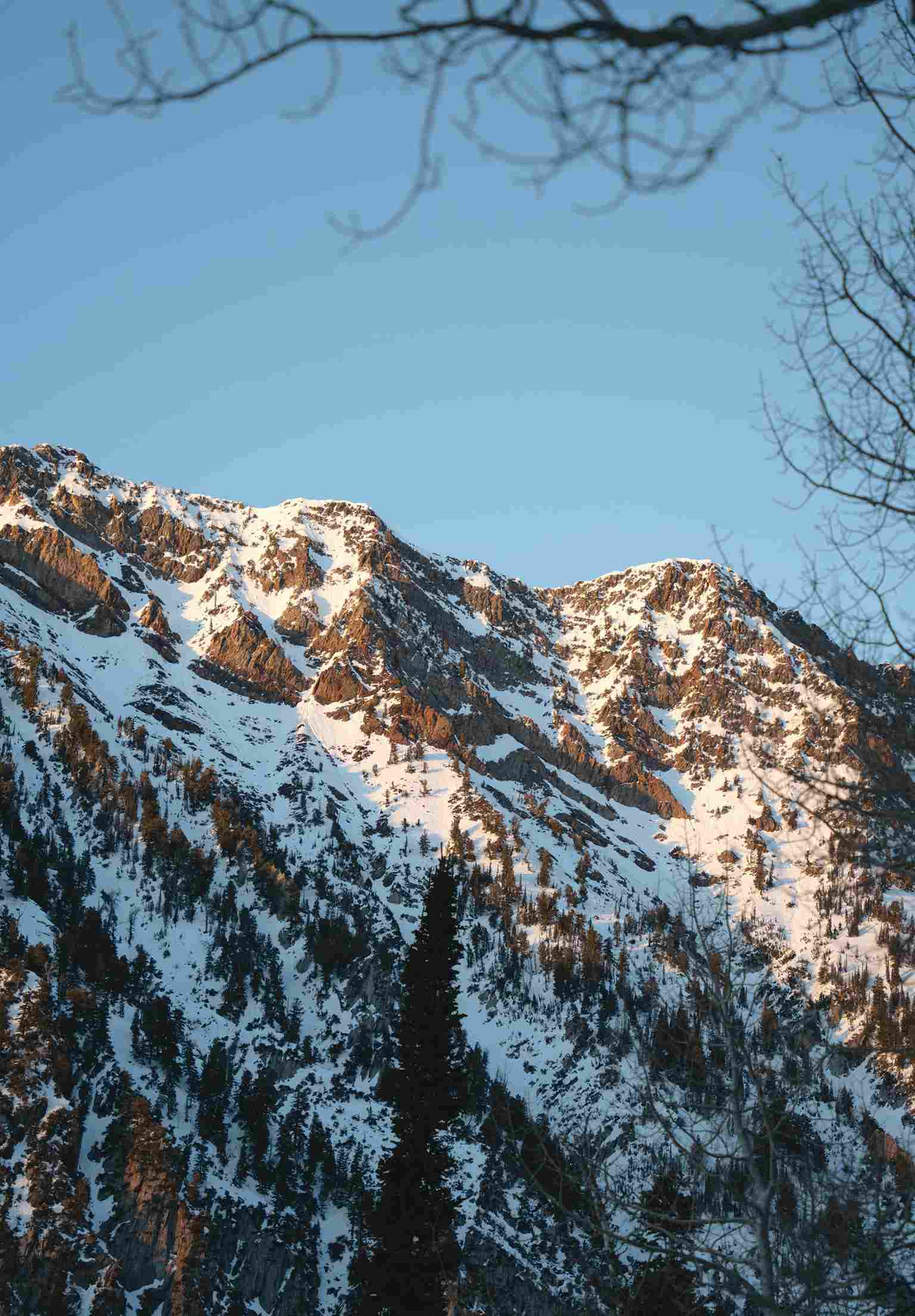
From downtown Salt Lake City, I took a 45-minute drive along the scenic Little Cottonwood Canyon Road to reach Alta Ski Area, the town closest to Albion Basin. With my GPS, finding the parking lot at the top was easy, right behind the Albion Grill.
After paying an $8 fee at the tollbooth, I started my hike on the trail, a small path that felt like stepping into wildflower heaven. The meadows were blooming with wildflowers, perfect for a mid-week day or weekend getaway with friends or family.
I talked to a helpful park ranger with questions, and the fully-equipped vacation rentals nearby made it an accessible workcation spot. Driving past the steep hill, the fields of the Wasatch offered inspiration, making this summer road trip a breeze to come to.
Directions
From the east side of Salt Lake City, I took I-215 to the 6200 South off-ramp and started my drive south, following road signs to Alta Ski Resort in Little Cottonwood Canyon. The journey ends at the paved road’s end, where an unpaved road, well-maintained and easily accessed by any passenger vehicle, leads to the Albion Basin Campground parking lot.
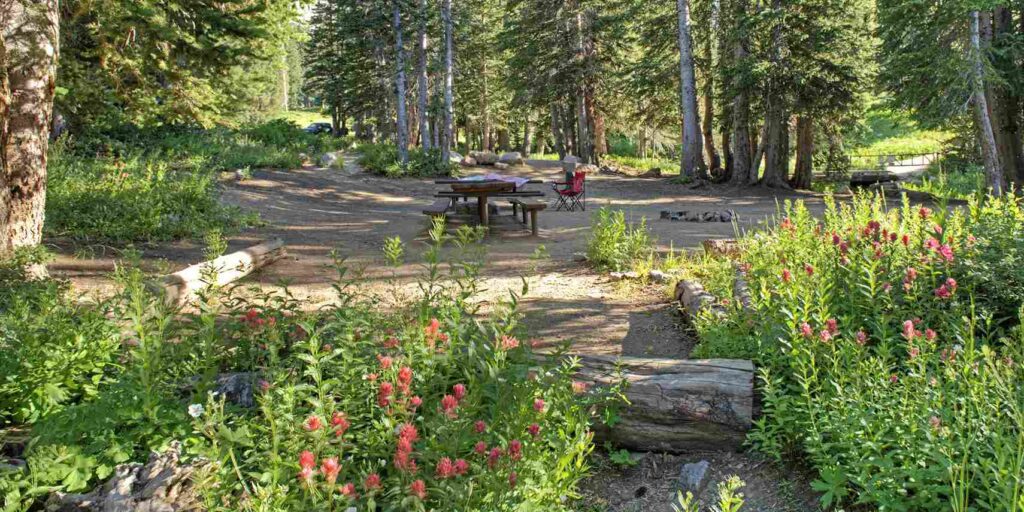
The last mile or two offers easy to moderate difficulty hikes, with parking limited at peak times as the number of vehicles allowed is controlled.
From my car window, the view of the display of wildflowers was stunning, making the unpaved portion of the road to the Basin a memorable start to the adventure.
Ownership and Management
When I visited Alta, Utah, the closest town to Albion Basin, I learned it’s lovingly managed by the U.S. Forest Service under the Wasatch-Cache National Forest. The Salt Lake Ranger District oversees this beautiful place.
I called 801-733-2660 for trail updates, and the rangers were so helpful, sharing tips to enjoy the National Forest. Their care makes this spot a treasure for everyone, keeping the Forest vibrant and welcoming for all who explore its colorful paths.
Alta Hiking Trails
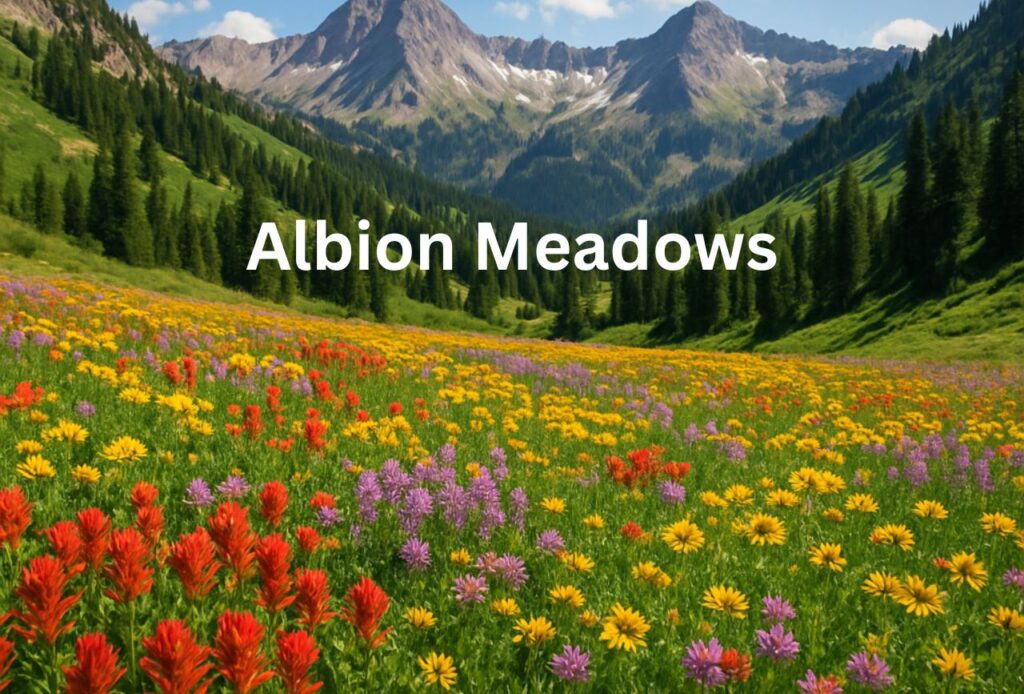
In northern Utah, the Albion Meadows trail bursts with vibrant wildflower displays in Late July and Early August, shaped by the year’s precipitation.
From the Lower Albion Meadows trailhead, easily reached near the Albion Base Trailhead by Albion Grill or Goldminer’s Daughter Lodge, I love a morning walk through lower meadows and upper meadows, where wildflowers carpeting the landscapes create incredible rugged alpine views.
Interpretive signs on the lower portion reveal history, geology, and wildlife, like the occasional moose near streams. Mountain bikes are not allowed, preserving the wildflower trails.
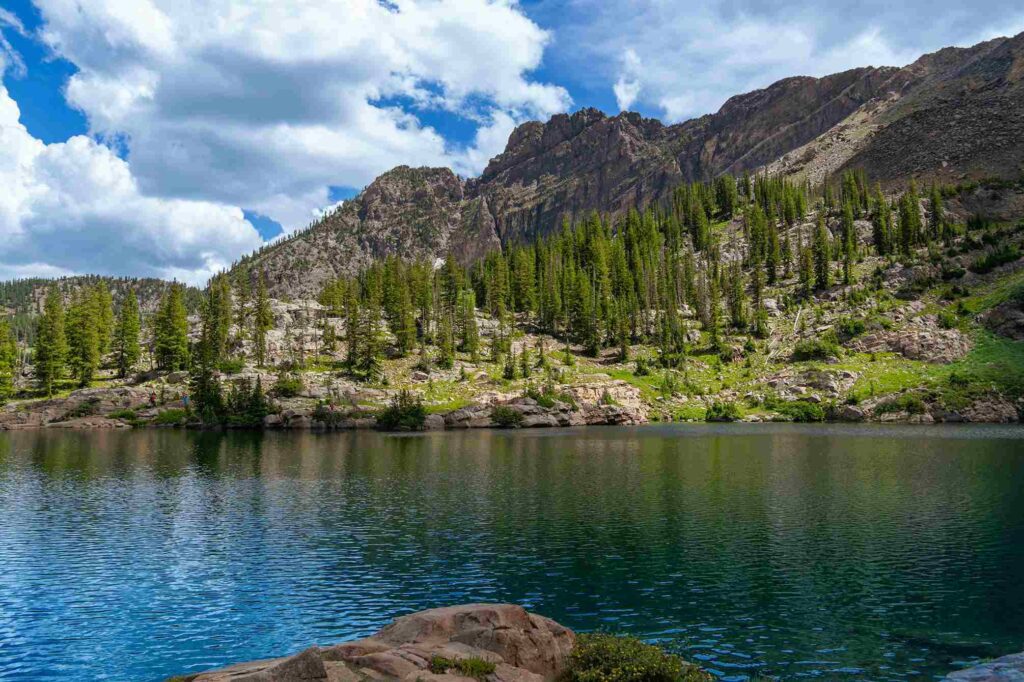
The Cecret Lake Interpretive Trail leads to the stunning Cecret Lake, an alpine lake in Albion Basin. Avid hikers can climb to higher altitude at Cardiff Pass, Twin Lakes Pass, Collins Gulch, Germania Pass, or East Greeley, weaving through Alta ski runs.
For a strenuous climb, Sugarloaf Mountain’s peak at 11,000 ft elevation in Brighton overlooks endless fields of wildflower meadows. Signage guides the favorite wildflower viewing, with layers of iconic display in the town of Alta.
Albion Basin Hike
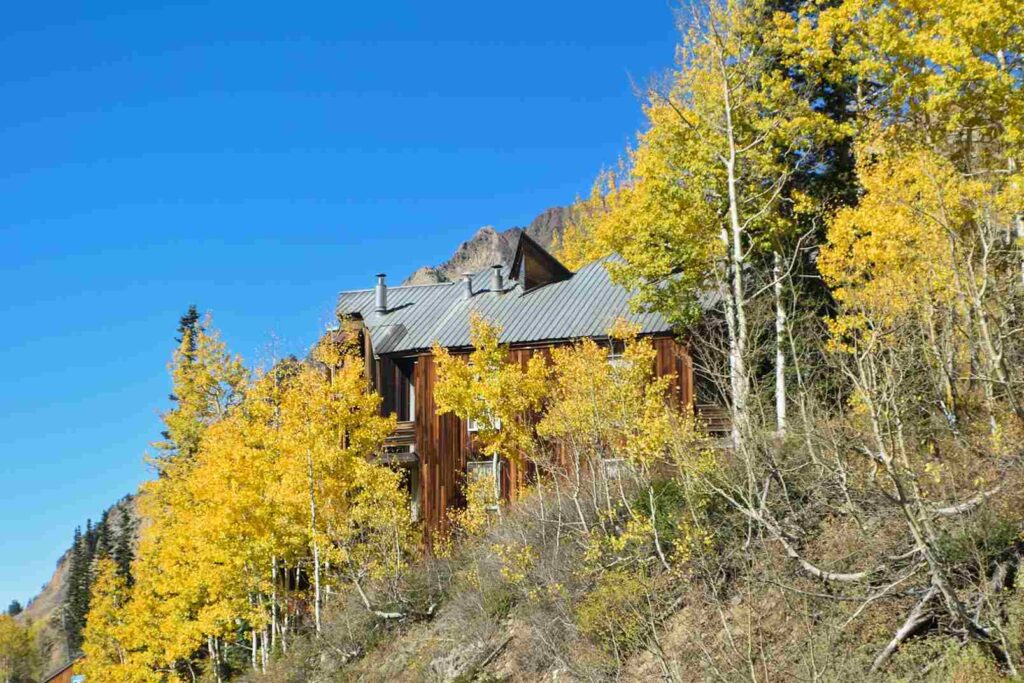
A 15-mile drive from Salt Lake City’s center leads to the top of Little Cottonwood Canyon, where I parked at the Albion Grill to hike the trail behind it. This easy, 1-mile path in the Wasatch-Cache National Forest weaves through pine trees and gorgeous meadows filled with beautiful wildflowers.
My first time in July, I was stunned by the spectacular wildflower-viewing in the glacially-carved Basin, located above Alta and Snowbird ski resorts at 9500 feet.
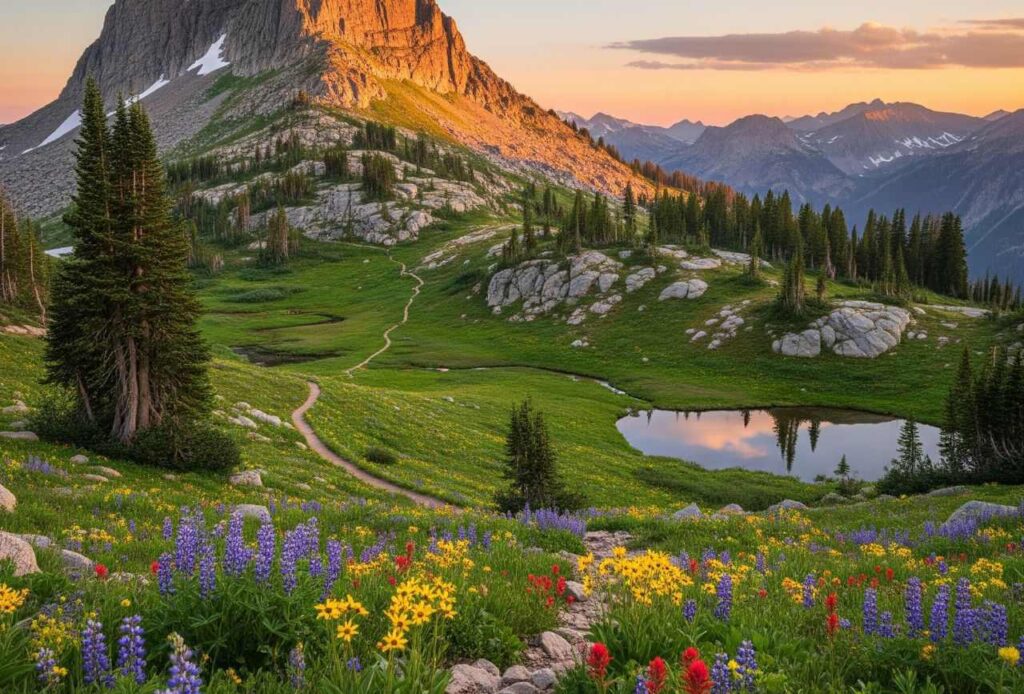
The trail takes you to a meadow with incredible mountain views of Devil’s Castle, perfect for photos by photographers and families. The area, a magical destination in the heart of the Wasatch mountains, is heavily trafficked but worth it for its unique wetland and geological features.
The trail ends at the alpine Cecret Lake, a great place for all ages and dogs allowed, offering ample recreational opportunities like hiking, bike riding, and camping. I kept my eyes peeled for wildlife like moose, as the area is prone to sightings.
In August, the Basin is a magnet for visitors drawn to its spectacular displays, rivaling Utah’s best skiing and tram rides. The steep incline didn’t stop my family from losing my breath at the renowned Intermountain Region views.
Wildlife to View
My mountain hike in Albion Basin was a thrill, spotting a yellow-bellied marmot, pika, and chickaree scampering through Utah’s wildflower trails. A golden-mantled ground squirrel darted by, while a moose and mule deer grazed nearby.
I saw mountain goats on rocky slopes, and the sky buzzed with gray-crown rosy-finch, black rosy-finch, red crossbill, Clark’s nutcracker, and tiny hummingbirds. Each creature made the scenery unforgettable.
When to Visit: Prime Wildflower Season in Utah
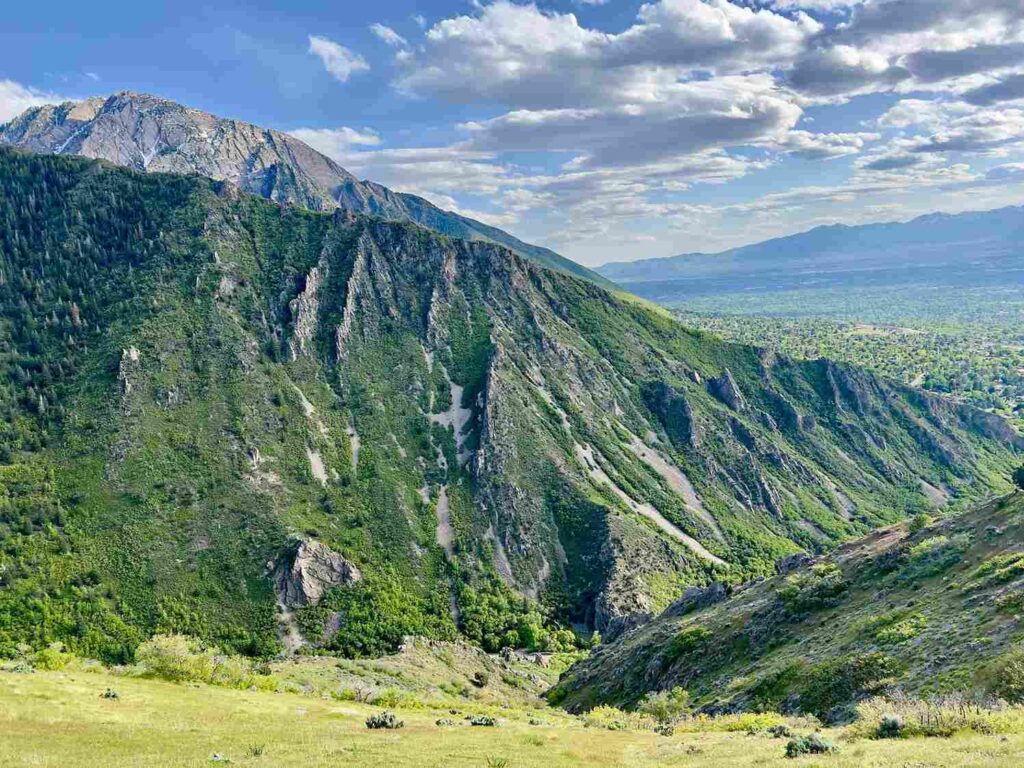
Starting in late June, Lower canyon trails like Millcreek Canyon’s Pipeline Trail burst with bloom, but by mid-July, Alta and Albion Basin became the wildflower equivalent of front-row concert tickets.
The highest meadows in Brighton shine through early August, with peak blooms stretching over six weeks. My hikes, guided by elevation, revealed vibrant June to August displays, making every step a colorful adventure in Albion Basin.
Albion Basin Wildflowers
In Albion Basin, the wildflowers create a stunning show, with different types of flowers blooming at different times of the year. My hike revealed that the second week of July kicked off the season, with lupine and Indian paintbrush splashing pinks, purples, blues, reds, and yellows across the lower part of the trail.
As I climbed higher, sunflowers and fire-weed joined the display, hitting their peak around August 3rd. The colors of lupine and other wildflowers in August made every step feel like walking through a vibrant painting, with the bloom transforming the Basin into a magical sight.
Albion Basin (Little Cottonwood Canyon)
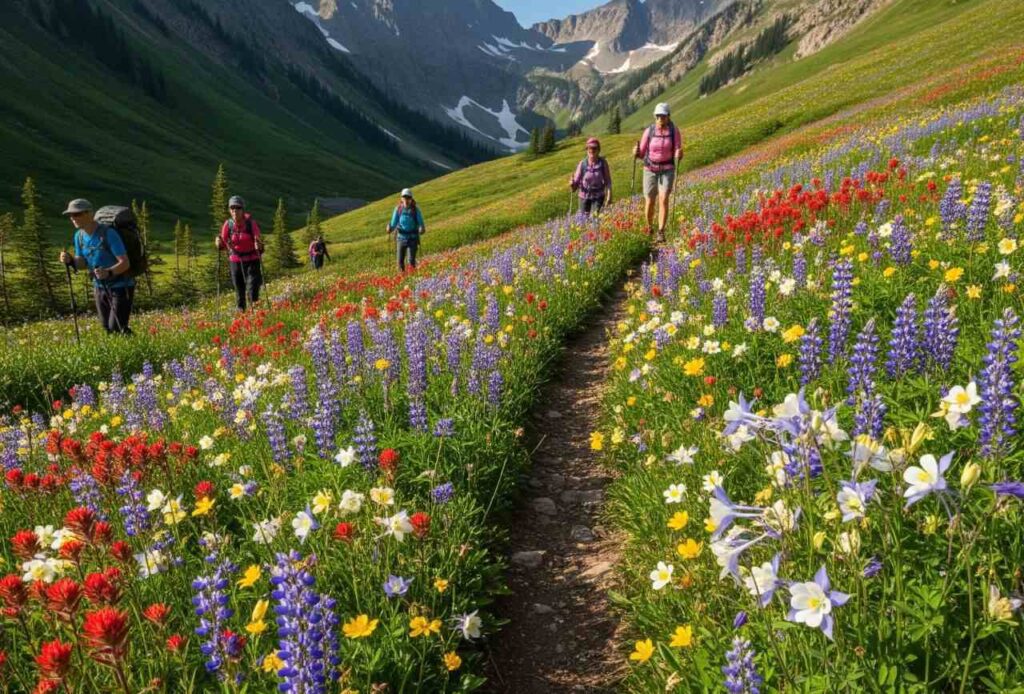
Starting at the trailhead, I wandered through meadows bursting with paintbrush, lupine, and columbine, their colors popping against the green. The trail was accessible with minimal huffing and puffing, making it a joyful hike that felt like stepping into a living painting.
Big Cottonwood Canyon
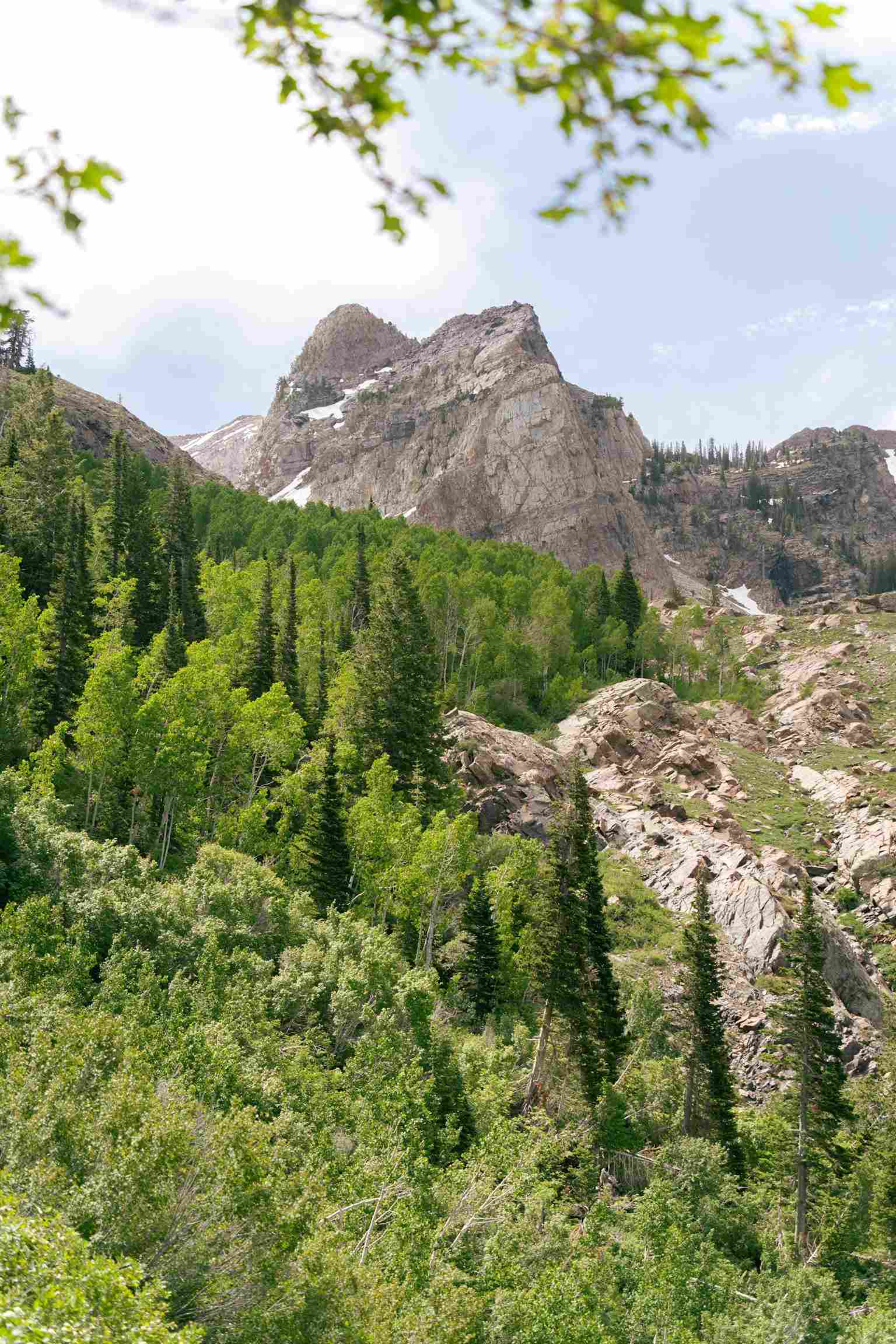
I spent my time exploring the wildflower spots in Big Cottonwood, where the Brighton Lakes became my sweet spot for a floral adventure. The moderate trails offered maximum flower power, leading me through fields of wildflowers that stretched endlessly.
The alpine lakes sparkled, reflecting the mountain peaks, creating a breathtaking backdrop that made every step feel like a painting come to life, blending vibrant colors with the serene beauty of this Big Cottonwood gem.
Millcreek Canyon
I discovered Millcreek Canyon, a local’s secret weapon, where early-season blooms burst under summer temperatures.
Just minutes from downtown, this canyon offers shaded trails for a cool escape, perfect for spotting the earliest wildflowers of the season. My hike along its east-west orientation gave me afternoon shade, making it a dream for photographers like me, capturing vibrant colors without needing much sunscreen.
The trail felt like a peaceful retreat, with Millcreek’s wildflowers sparkling like a hidden gem near Albion Basin.
Top 5 Wildflower Hikes for Beginners and Families
Cecret Lake
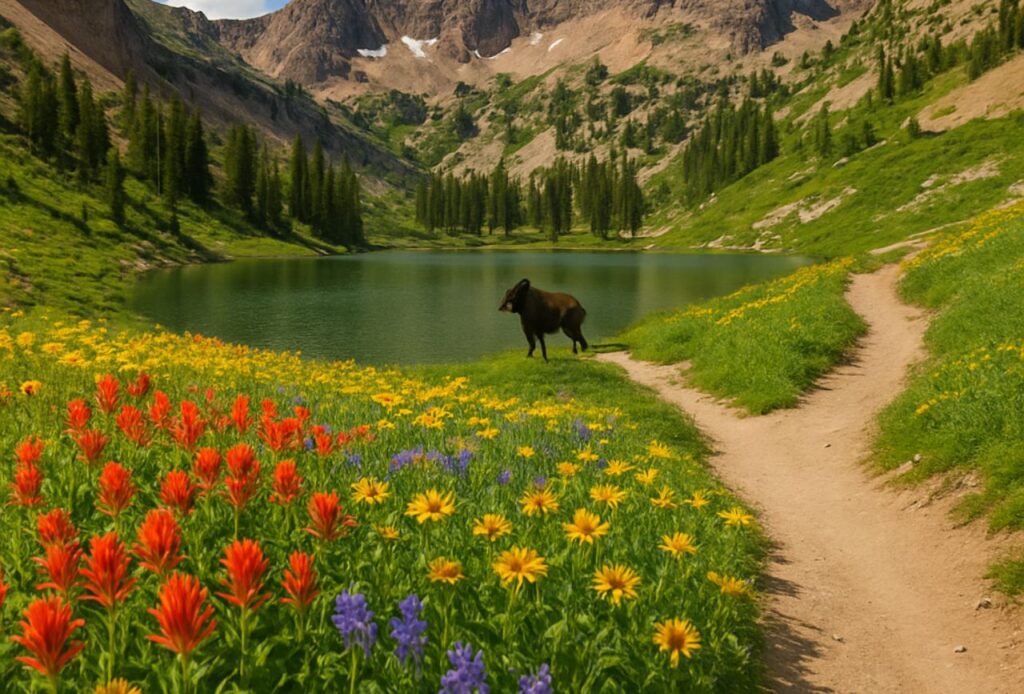
My 1.8-mile round-trip hike to Cecret Lake felt like the wildflower equivalent of winning the lottery!
The trail, perfect for flower enthusiasts, offers a gentle climb through fields bursting with vibrant colors that look almost Photoshopped.
I spotted a moose making guest appearances, adding thrill to this one wildflower hike. The path led to a pristine alpine lake, where the beauty of Albion Basin shone, making it a joyful adventure for families and beginners alike.
Donut Falls (Big Cottonwood)
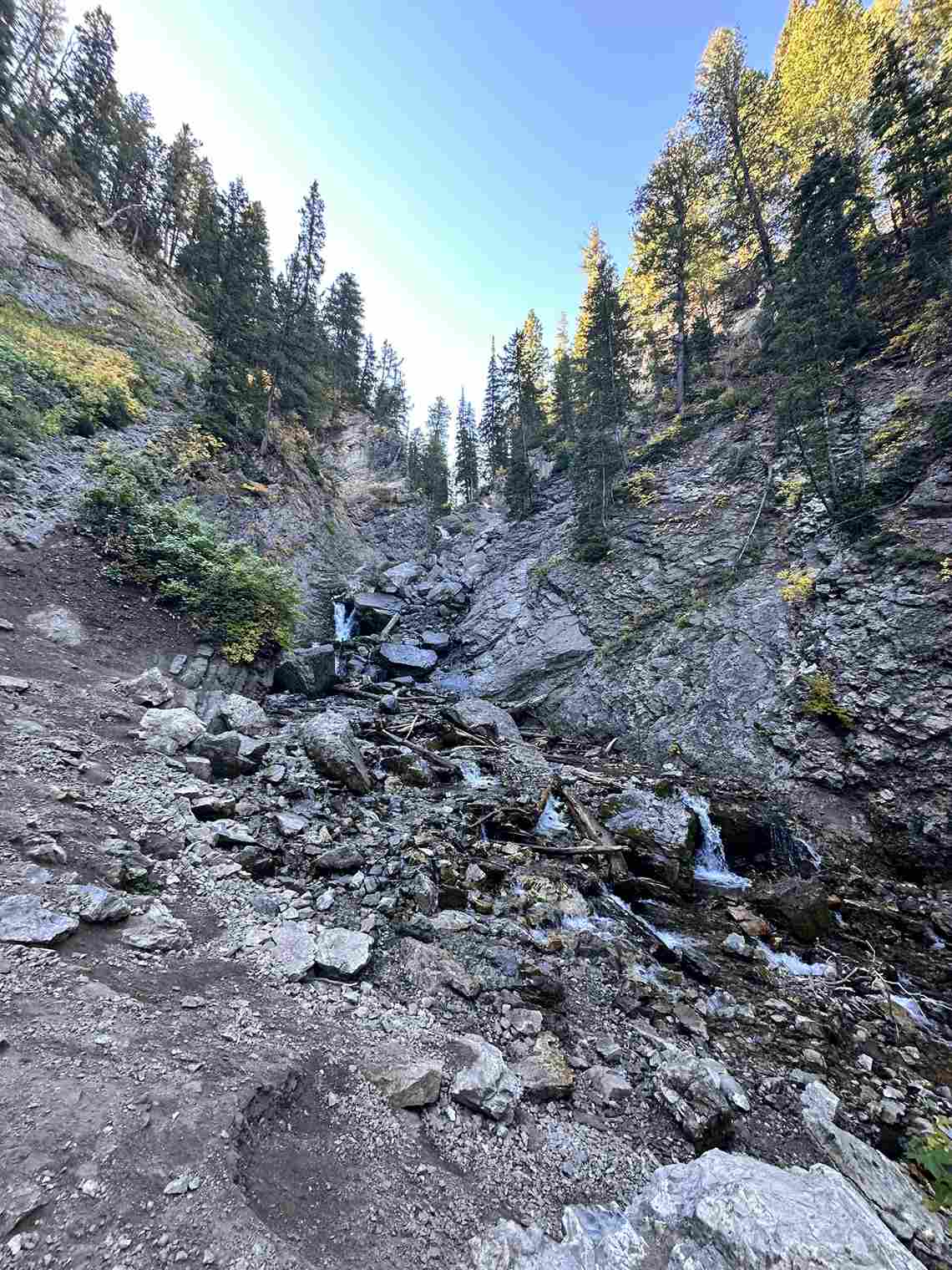
Tucked in Big Cottonwood, the Donut Falls hike is a gem I stumbled upon last summer, and it’s a must for anyone chasing wildflowers and waterfalls.
This 3-mile round-trip trail is a breeze for parents and kids, with a moderate grade that won’t wear you out. The path, lined with plentiful shade, keeps you cool even as the heat creeps in.
I loved watching my nephews scrambling over rocks near the natural stone arch, where water pours through a quirky name-worthy hole. Get there by 9am to dodge the crowds and soak in the vibrant blooms—trust me, the early start makes all the difference!
Silver Lake Loop (Brighton)
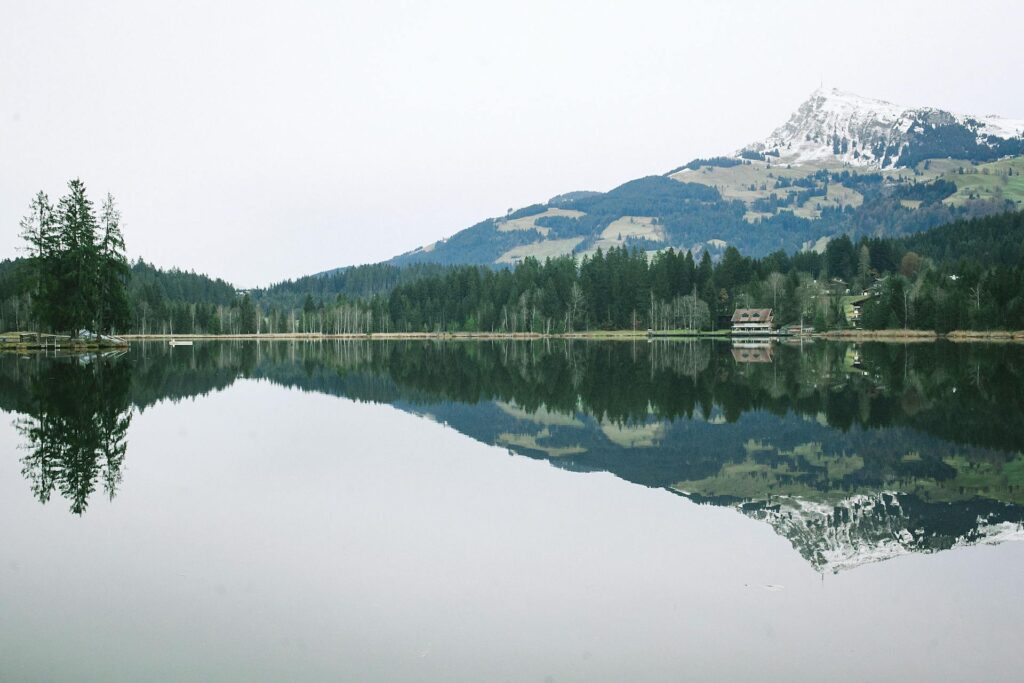
Last weekend, I wandered the Silver Lake Loop in Brighton, a perfect spot for soaking up wildflowers in ALBION BASIN. This 0.8-mile boardwalk loop is a flat, family-friendly trail with wheelchair access and room for a stroller, making it a breeze for everyone.
The walkway circles a serene mountain lake, where I spotted moose munching in the shallows and marmots sunning on rocks.
Kids were giggling, wading in the water, while tourists snapped photos near Main Street. It’s a quick, vibrant escape—my heart’s still full from the views!
Wildflower Trail (Snowbird)
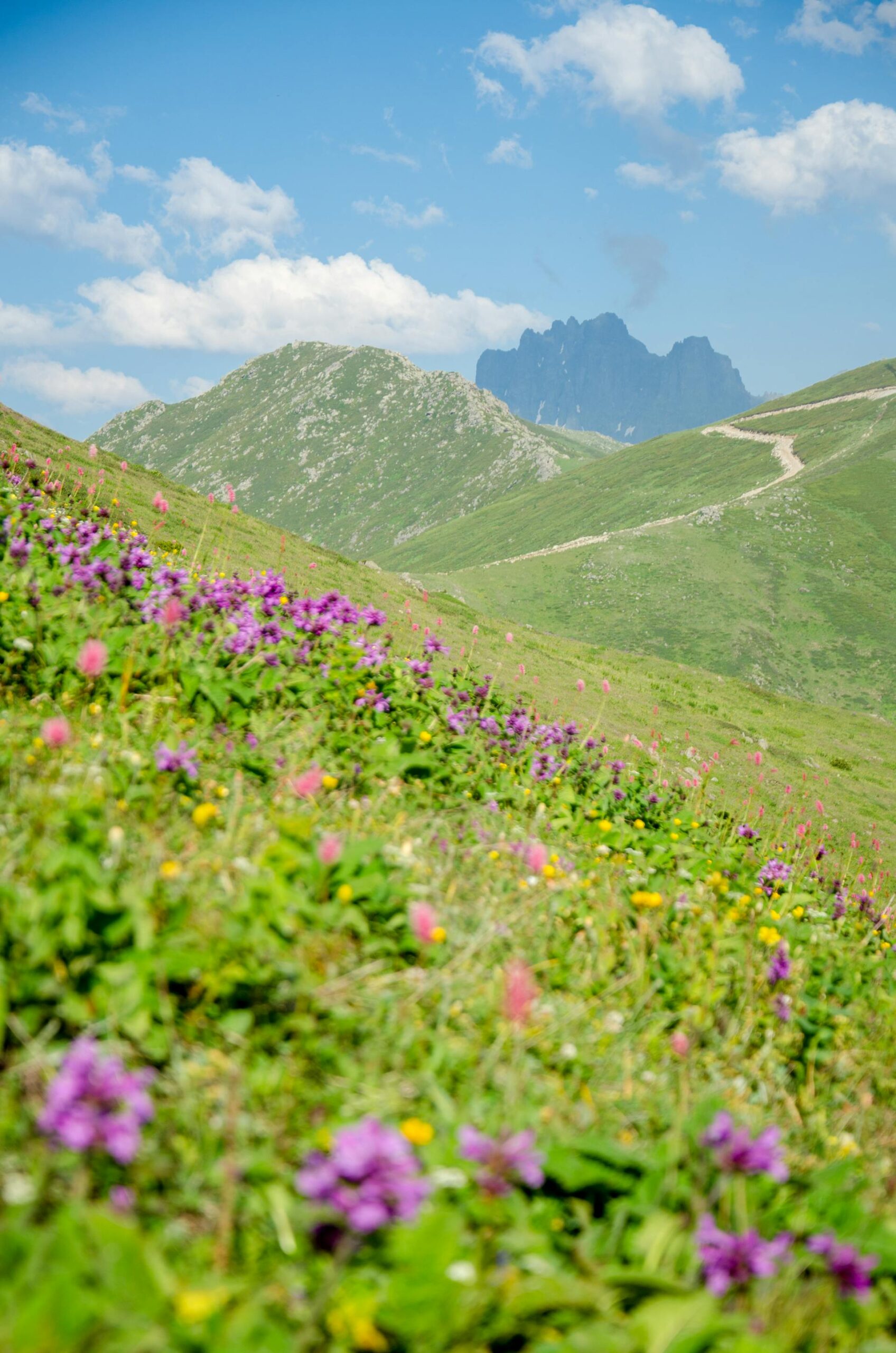
My summer hike at Snowbird’s Wildflower Trail was a burst of beauty I’ll never forget, with wildflowers painting the 1-mile Observation Trail.
Starting with the scenic ride on the Aerial Tram, I soared 2,900 vertical feet to Hidden Peak, where sweeping valley views of Salt Lake and downtown unfolded.
The trail, ideal for families with little ones, felt 10-15 degrees cooler than the heat below, perfect for hiking.
After walking through the Wildflower Tunnel near the Peruvian chairlift, I stopped at Summit Lodge atop for a drink and lunch. Smart adventuring means catching the tram from Snowbird Center—it’s a bucket-list experience! Note: trails open around July 15, so plan your time wisely.
Lower Bell Canyon Reservoir

Last July, I hiked the 2.4-mile loop around Lower Bell Canyon Reservoir, a hidden spot near Sandy that’s bursting with wildflowers and stunning water views.
The trail’s gentle elevation suits all mountain goat fitness levels, and I loved pausing at benches to soak in downtown vistas.
A half-day adventure, it’s best to wear sturdy shoes, pack sunscreen, water, and layers for unpredictable mountain weather—the hot sun can flip to afternoon showers fast.
Afterward, I treated myself to post-hike gelato in town, the perfect reward for this ALBION BASIN gem!
Advanced Trails for Serious Hikers and Photographers
Lake Blanche Trail (Big Cottonwood)

My determined hike on the Lake Blanche Trail in Big Cottonwood was a 6.8-mile round-trip journey that tested my legs but delivered big!
Perfect for casual hikers ready for some quad-burning effort, the reward is a stunning alpine lake framed by Sundial Peak. The meadows burst with columbine and lupine, looking like stained glass in the morning light—set an alarm to catch this glow! Every step through the wildflowers grabbed my attention, making this ALBION BASIN trek unforgettable.
Cecret Lake to Sugarloaf Peak (Little Cottonwood)
Last summer, I trekked the Cecret Lake trail in Little Cottonwood, chasing the spectacular wildflowers that make ALBION BASIN magical. The 4-mile round-trip extension to Sugarloaf’s 11,051-foot summit was a climb, with thin air making every step feel big, but the flowers blooming everywhere were worth it.
The wildflower-to-tourist ratio was perfect—quiet enough to enjoy nature without crowds. I snapped tons of shots with my camera, and yes, my selfie stick got some epic views of the vibrant blooms against the rugged peak!
Mount Olympus Trail
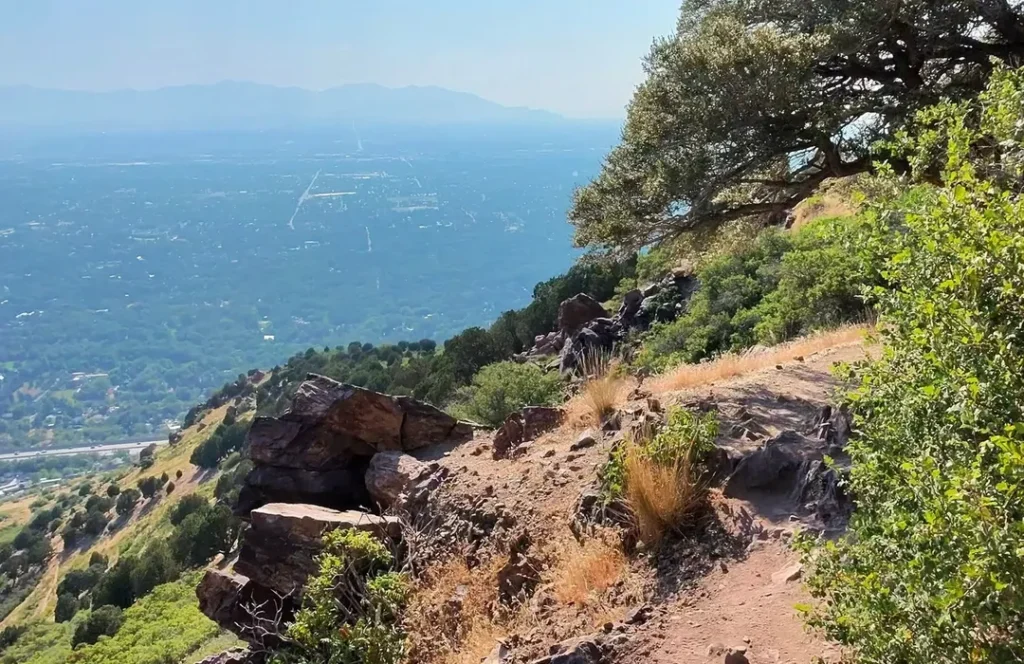
I tackled the Mount Olympus Trail, a 7-mile round-trip beast in ALBION BASIN that’s all about bragging rights. The climb, with a grueling 4,000 feet elevation, had me puffing, but the wildflowers and blooms kept me going.
Among Salt Lake’s recognizable peaks, I used every excuse to stop and catch my breath, soaking in views of the Great Salt Lake shimmering in the distance.
Reaching the top was my morning’s work, and the Salt Lake Valley spread below like a map—pure magic worth every step!
Where To Go Wildflower Viewing In Alta, Utah
I took a drive up the steep, winding roads of Little Cottonwood Canyon to Alta, where the Ski area became a paradise for wildflower lovers and hikers.
From the parking lot at the top of the Sunnyside lift by Albion Basin Campground, I wandered miles of trails, my phone ready to fill with photo opportunities of high-elevation fields bursting with paintbrush, columbine, lupine, Jacob’s ladder, and penstemons—over 120 species listed in the Albion Basin Plant Checklist (PDF, 98 KB).
The meadows in Utah’s Albion Basin are a spectacular sight, especially in July and August, when Snowbird resort’s tram rides showcase vibrant alpine flower displays.
I laced up my comfy hiking boots, grabbed a hat, and slathered on sunscreen to handle the high temperatures and low humidity—the thinner air at these elevations slows you down compared to sea level.
A mountain thunderstorm can surprise you, so I packed water for my thirsty self and bug spray for the shade.
The canyon roads, with their curves and pullouts, are a favorite for locals, and I kept my camera in the car’s trunk for quick stops. This area appeals to anyone who loves wildflowers and mountains—a true Utah gem that makes every head turn!
Wildflower Identification: What You’ll See
1. Indian Paintbrush
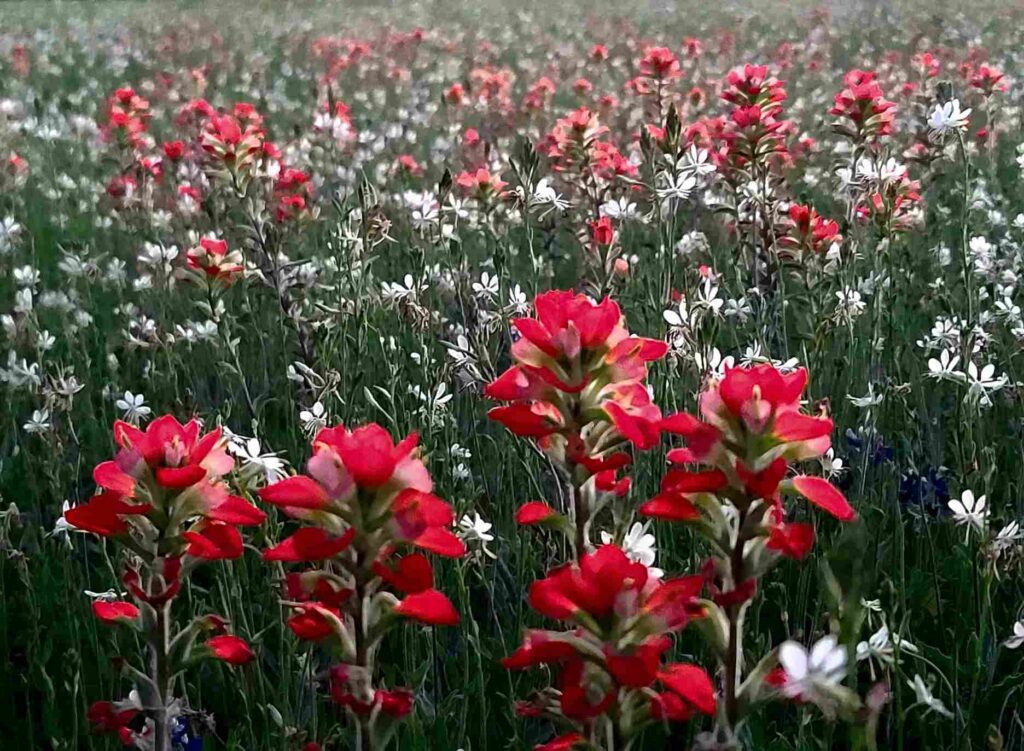
I hiked the trails of ALBION BASIN in Utah, and the Indian Paintbrush stole the show with its vibrant red blooms. These crimson paintbrush tips are like extroverts in the wildflower world, making a bold statement on the mountainside.
They’re impossible to miss, popping against the Wasatch greenery, and I couldn’t help but snap photos of their vibrant glow in the wildflower scene.
2. Columbine
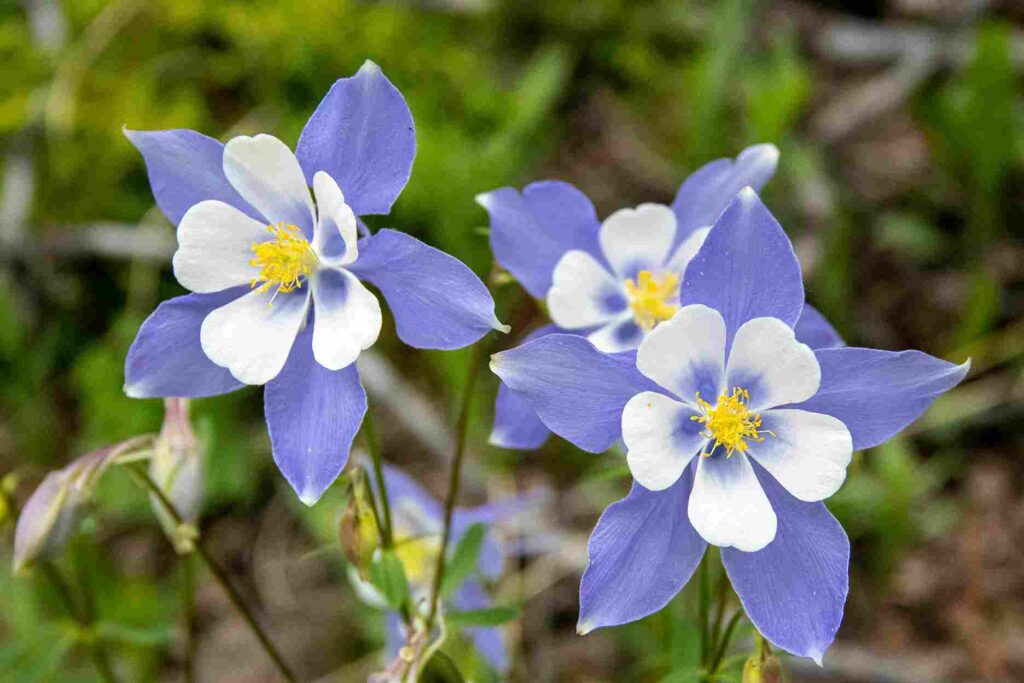
The Columbine added a touch of elegance to the shadier spots of ALBION BASIN’s understory. Their distinctive yellow center with spurred blue petals or spurred white petals looked like flowers in formal wear, ready for a ball.
I watched them dance in the breeze along the Utah trails, their beauty making the wildflower scene feel like a quiet, graceful retreat.
3. Lupine
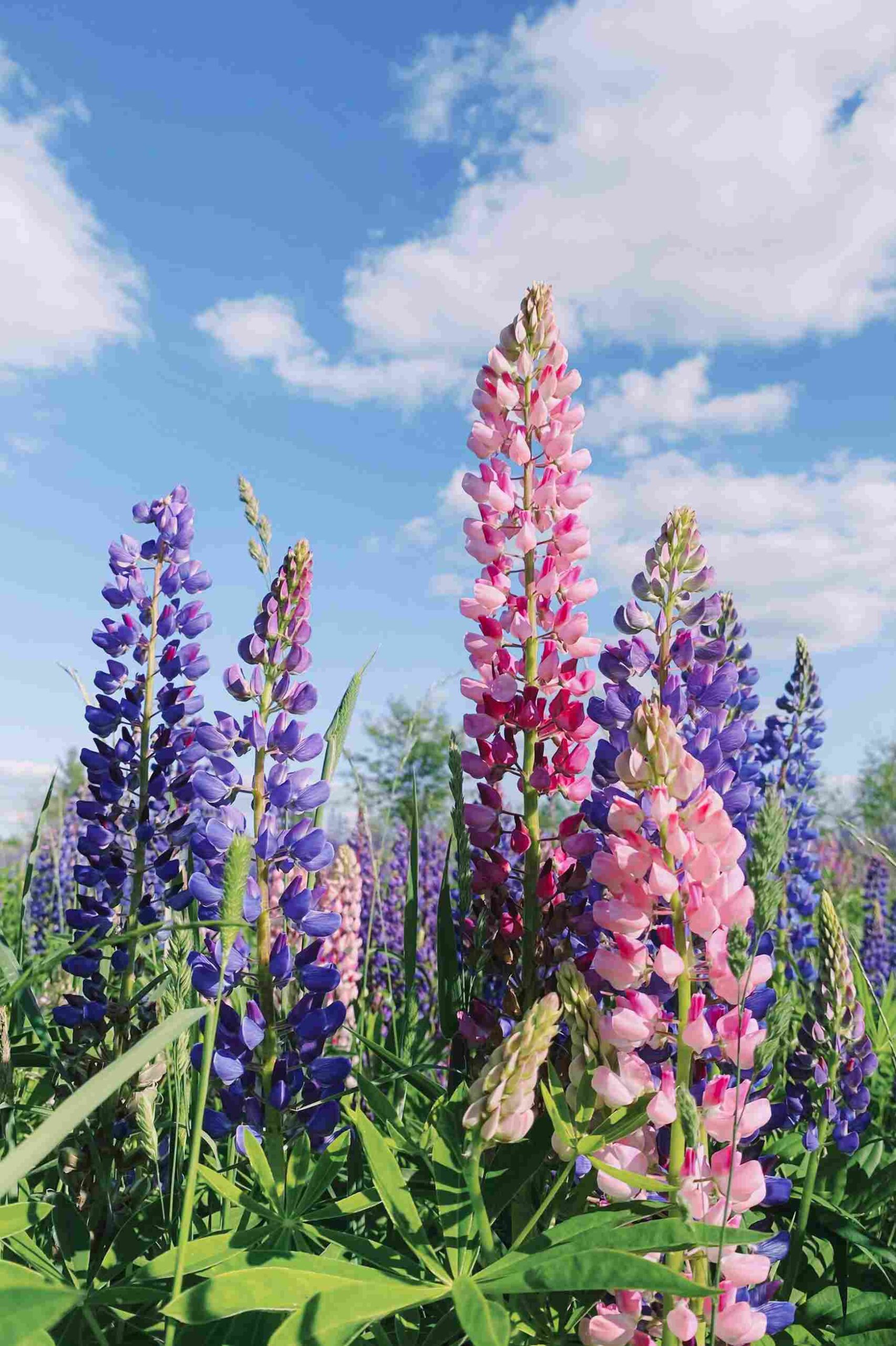
Lupine turned the fields into purple lakes, their tall, purple-blue spikes and star-shaped clusters creating a symmetrical display perfect for social media. These blooms contrast beautifully with ALBION BASIN’s green mountainsides, and I spent a July morning in the meadows, stunned by how they lit up the Wasatch wildflower scene.
4. Wasatch Penstemon
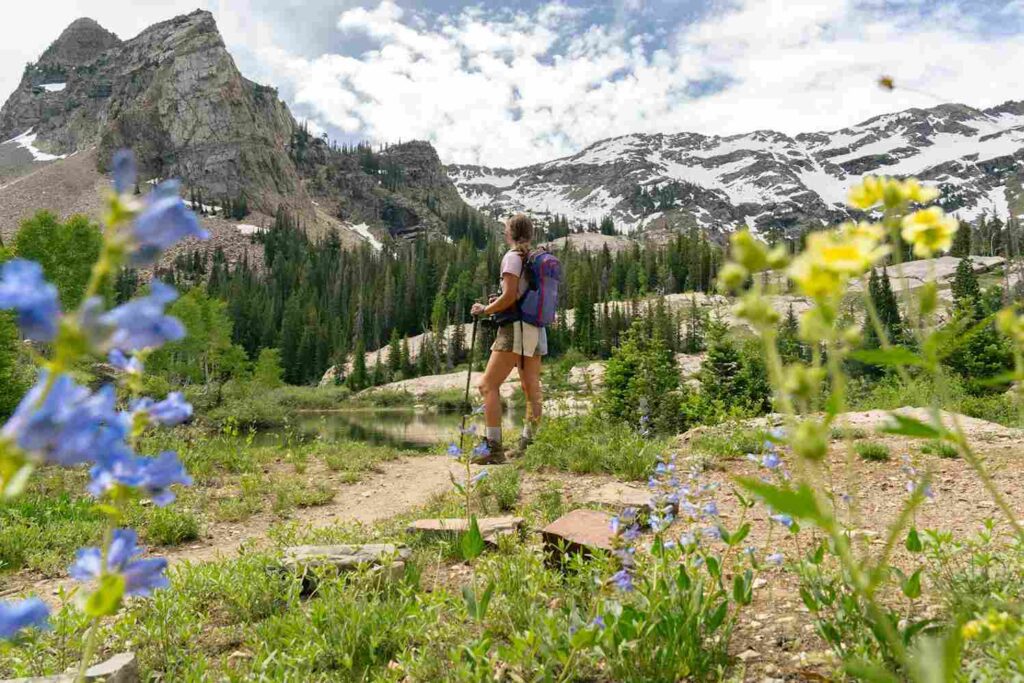
The Wasatch Penstemon greeted me like botanical welcomers along the trails, their purple, trumpet-shaped flowers buzzing with hummingbirds performing aerial acrobats on their rounds.
I loved to sit quietly in ALBION BASIN, watching these lively visitors dart through the wildflower scene. Their Utah charm made every mountainside moment unforgettable.
5. Sego Lily
The Sego Lily, Utah’s state flower, dotted the mountain greenery with small white stars. These delicate blooms show resilience, once saving pioneers with their bulbs during tough times. They’re protected in ALBION BASIN, so I kept my hands off and let my eyes admire their beauty, a perfect piece of the Wasatch wildflower scene.
Don’t Miss the Wasatch Wildflower Festival
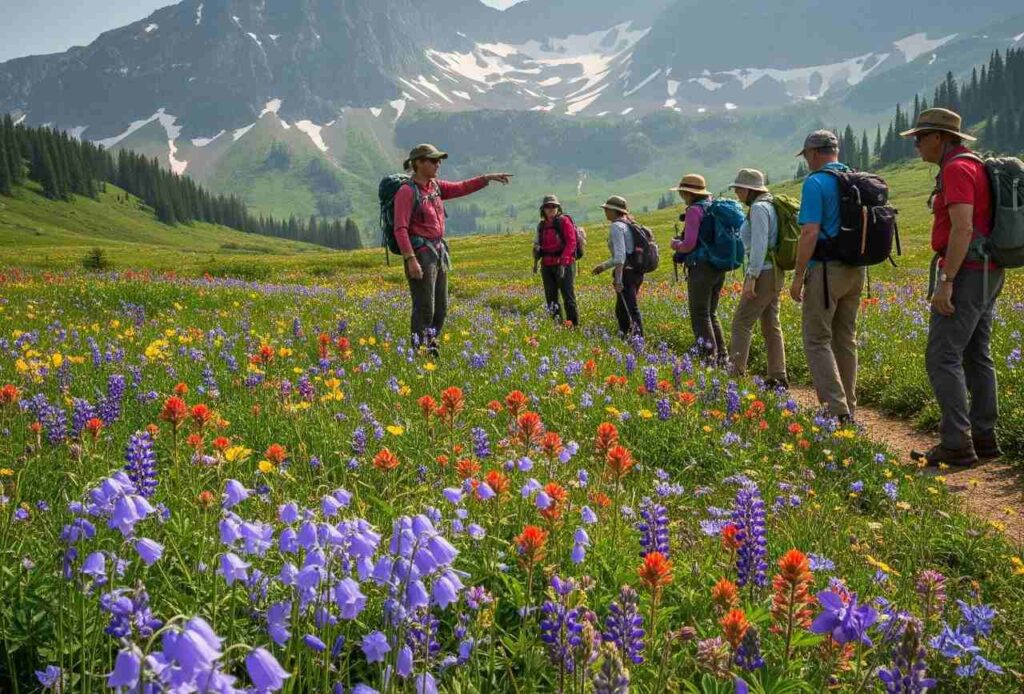
Every July, I head to the Wasatch Wildflower Festival in ALBION BASIN, a multi-day event hosted annually by the Cottonwood Canyons Foundation. It celebrates the beauty and diversity of wildflowers across four ski areas: Brighton Resort in Big Cottonwood Canyon on Saturday, July 9th, Solitude Mountain Resort on Sunday, July 10th, Snowbird in Little Cottonwood Canyon on July 16th, and Alta Ski Area on July 17th.
This free community effort, which began in 1996, is popular and registration is required. I joined guided hikes with local experts and trained naturalists, learning flower identification for bluebells and harebells while exploring the protected watershed’s ecology—it’s like a botanical theme park inside the Wasatch Mountains.
The Festival offers family-friendly activities for every age and ability, with easy, moderate, and advanced self-guided walks. I used a paper map and digital app to track my path, spotting delicate blooms that are tempting to pick but heavily fined—so respect the leave no trace rule and stay on designated trails to avoid trampling natural resources.
The Alta-Snowbird area is a nature gem with plenty of colorful photo ops, making me feel like a botanical wizard. After a walk, my appetite led me to Snowbird’s restaurants for food, drinks, and live music.
Kids love the crafts and games, while small towns buzz with fun. The Annual event, sponsored by Uinta-Wasatch-Cache National Forests, includes a Tram ticket at an expense for amazing views.
Book in advance—spots sell out fast! My visit to this range of festivities was the best experience, connecting me to the community and the colorful indigenous wildflowers of ALBION BASIN.
Staying Safe on the Trails
Last summer, I learned the wildflower code while hiking ALBION BASIN’s trails, and it kept me safe in the canyons. Stick to the trail to avoid harming delicate plants and soil—no wandering for that perfect Instagram shot or likes, as footprints hurt wildlife like squirrels and moose.
Keep a distance while observing the wild beauty, and don’t rely on cell service—grab a trail map instead.
The mountain sun is stronger than hometown rays, so I used sun protection to stay safe. Weather can shift fast with afternoon thunderstorms, so plan with punctuality like a Swiss watch and take pictures carefully to protect this Utah gem.
Where to Stay Near Albion Basin
My summer staycation at the Snowpine Lodge, a 4-star hotel in Alta, was perfect for visiting ALBION BASIN’s wildflower trails like Cecret Lake Interpretive Trail, Cardiff Pass, Twin Lakes, Brighton, Collins Gulch, Germania Pass, and East Greeley.
This family-friendly spot, a favorite among locals, offers an outdoor pool, spa, on-site restaurant, and arcade, with alpine views right at your front door.
A hike on these heavily trafficked but worthwhile trails is a Utah bucket list must, and the welcoming team, with 30 years as Wasatch guide experts, makes it a unique home away from town.
“I recommend Chalets too for the best alpine experiences—I’m already returning next year!”
Why Wildflower Season in Salt Lake is So Magical
In mid-July, the mountains of Albion Basin in Little Cottonwood Canyon burst into a vibrant display of summer magic, a stark contrast to the serene, snow-dusted charm of A Visit To Antelope Canyon In Winter.
As I trekked through the Wasatch Range, each step unveiled a stunning backdrop of fields alive with neon Indian Paintbrush, elegant Columbine, and purple-blue lupine, forming a colorful carpet beneath jagged peaks. This flower show, shifting with the elevation gradient over days and weeks, feels like nature’s own art exhibition.
My all-day expedition under the warm sun filled my camera roll with shots that screamed for an upgrade, each moment a dream of summer beauty that makes you wish you could bottle it up forever.
What Else to Do in Salt Lake After Hiking
After hiking among ALBION BASIN’s wildflowers and columbines, I love exploring Salt Lake’s vibrant city scene. Downtown’s The Green Pig Pub offers great food like chili verde nachos and live music on its rooftop bar, perfect for relaxing with Wasatch views.
For chic vibes, Ivy & Varley serves creative cocktails and eclectic dishes on a huge local dining patio, ideal for families craving a family-friendly atmosphere.
Van Ryder stuns with city views and craft drinks, while Red Iguana delivers authentic Mexican cuisine with bold moles in a warm setting.
For cozy scenic canyon dining, Silver Fork’s fluffy pancakes hit the spot. Check the Wasatch Wildflower Festival website for festival schedules, events, and information to catch more wildflower fun, rounding out Salt Lake’s welcoming culinary scene with tasty restaurants!
Faq
Where are the wildflowers in Albion Basin?
The Albion Basin, a crown jewel of Salt Lake’s wildflower scene, sits at the top of Little Cottonwood Canyon. As someone who’s roamed these slopes, I’m always in awe of how this winter powder skiing haven transforms into a wildflower wonderland by July. Albion’s vibrant wildflowers deliver a stunning display, carpeting the Canyon in colors that make every hike feel magical.
How hard is the Albion Basin hike?
The Albion Basin hike is easy and great for all skill levels, perfect for a peaceful walk in the Wasatch Range. I’ve loved hiking here, starting at the trailhead at 9000 feet elevation, where the easiest paths let you watch wildlife in this beautiful area. Dogs are allowed, but off-road bike routes are not, keeping the Basin serene for everyone.
When can you see wildflowers in Utah?
Utah’s wildflowers bloom in higher-elevation meadows from March to September, with the peak season in June, July, and August. I’ve hiked Albion Basin often, and the summer bloom transforms the meadows into a colorful paradise, making every visit unforgettable.
Do you have to pay to get into Albion Basin?
To reach Albion Basin at the top of Little Cottonwood Canyon, you drive to the end of the highway where a ranger booth collects a $10 entry fee. I’ve driven this dirt road for the last 2 miles many times, and the fee to enter the Basin is a small price for its breathtaking wildflower beauty.

